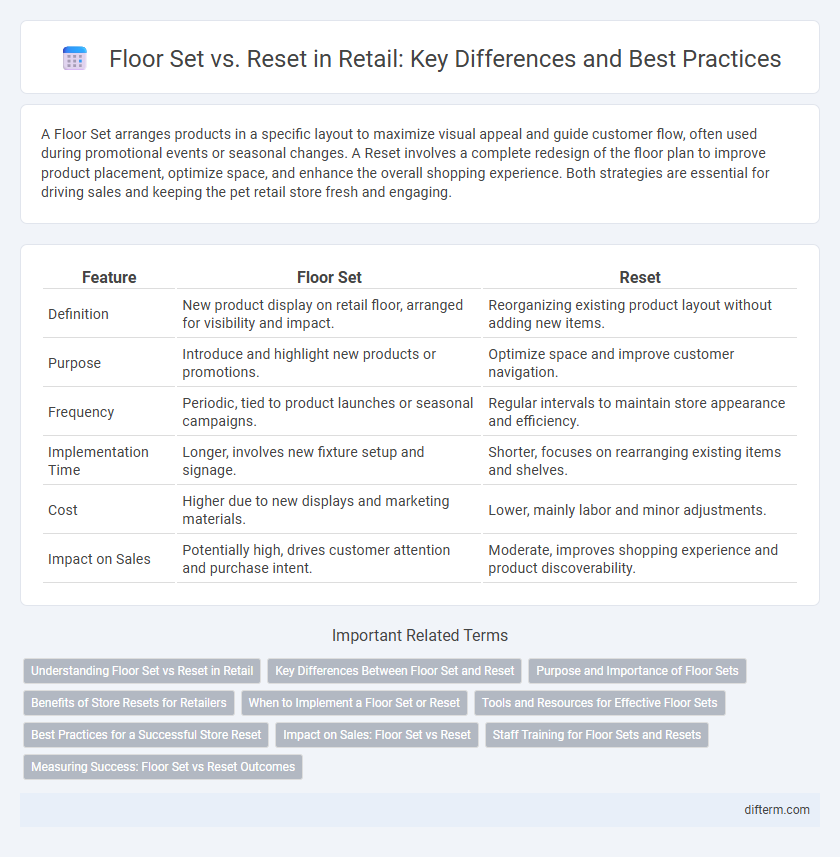A Floor Set arranges products in a specific layout to maximize visual appeal and guide customer flow, often used during promotional events or seasonal changes. A Reset involves a complete redesign of the floor plan to improve product placement, optimize space, and enhance the overall shopping experience. Both strategies are essential for driving sales and keeping the pet retail store fresh and engaging.
Table of Comparison
| Feature | Floor Set | Reset |
|---|---|---|
| Definition | New product display on retail floor, arranged for visibility and impact. | Reorganizing existing product layout without adding new items. |
| Purpose | Introduce and highlight new products or promotions. | Optimize space and improve customer navigation. |
| Frequency | Periodic, tied to product launches or seasonal campaigns. | Regular intervals to maintain store appearance and efficiency. |
| Implementation Time | Longer, involves new fixture setup and signage. | Shorter, focuses on rearranging existing items and shelves. |
| Cost | Higher due to new displays and marketing materials. | Lower, mainly labor and minor adjustments. |
| Impact on Sales | Potentially high, drives customer attention and purchase intent. | Moderate, improves shopping experience and product discoverability. |
Understanding Floor Set vs Reset in Retail
Floor set in retail refers to the initial arrangement and presentation of products on the sales floor, designed to maximize customer engagement and optimize product visibility. Reset involves reorganizing or updating the existing floor set to accommodate new merchandise, seasonal changes, or promotional strategies, ensuring the layout remains relevant and appealing. Both processes are critical for driving sales, improving shopper experience, and maintaining efficient inventory management.
Key Differences Between Floor Set and Reset
Floor set involves the initial arrangement of new merchandise on the sales floor, emphasizing product placement and visual merchandising to attract customers. Reset refers to reorganizing or overhauling existing floor sets to update product displays, incorporate seasonal items, or improve store layout for better traffic flow. Key differences include timing, where floor sets occur during new product launches and resets happen during mid-season updates, and scope, with resets typically being more extensive in altering fixture positions and signage.
Purpose and Importance of Floor Sets
Floor sets are designed to establish the initial visual merchandising layout that maximizes product visibility and customer engagement in retail spaces. Their purpose is to create an organized and attractive environment that supports sales goals and enhances the shopping experience by strategically placing key items in high-traffic areas. Effective floor sets drive inventory turnover and brand consistency, making them crucial for capturing consumer attention and boosting overall store performance.
Benefits of Store Resets for Retailers
Store resets enable retailers to optimize product placement, enhancing customer navigation and increasing sales potential. By updating store layouts according to current trends and inventory, resets improve shopper experience and inventory turnover. This strategic refresh also supports better merchandising alignment with seasonal promotions and new product launches.
When to Implement a Floor Set or Reset
Implement a floor set when launching a new product line, store opening, or seasonal transition to create a fresh and engaging shopping experience. Opt for a reset during mid-season promotions or major merchandise reorganizations to optimize product placement based on sales data and shopper behavior. Timing these interventions strategically maximizes inventory turnover and enhances overall store performance.
Tools and Resources for Effective Floor Sets
Effective floor sets leverage specialized tools such as planogram software, digital shelf-mapping systems, and mobile scanning devices to ensure precise product placement and real-time inventory updates. Resource allocation includes trained visual merchandisers and cross-functional teams adept at rapid execution and maintaining brand consistency across retail environments. Utilizing these tools and expert personnel enhances accuracy, reduces downtime, and maximizes sales potential through optimized product presentation.
Best Practices for a Successful Store Reset
A successful store reset hinges on meticulous floor set planning that maximizes product visibility and shopper flow by aligning merchandise categories strategically and using data-driven heat maps. Maintaining consistent brand standards while allowing flexibility for local market preferences enhances customer experience and drives sales growth. Implement cross-functional teams including merchandising, operations, and marketing early in the planning stage to ensure seamless execution and minimize downtime.
Impact on Sales: Floor Set vs Reset
Floor sets create immediate visual impact by introducing entirely new product arrangements that can significantly boost customer interest and impulse purchases, driving short-term sales spikes. Resets, involving adjusted product placements within existing layouts, enhance navigability and product discovery, contributing to sustained sales growth over time. Retailers leveraging floor sets often see higher initial sales lifts, while resets support consistent revenue by optimizing shopper experience and inventory flow.
Staff Training for Floor Sets and Resets
Effective staff training for floor sets and resets enhances product placement accuracy and store layout consistency, directly impacting customer experience and sales performance. Training programs should emphasize merchandising standards, planogram compliance, and time management to ensure seamless transitions and minimal disruption. Equipping staff with hands-on practice and clear guidelines drives efficiency in executing both floor sets and resets, maximizing retail operational success.
Measuring Success: Floor Set vs Reset Outcomes
Measuring success in retail floor sets versus resets hinges on key performance indicators such as sales lift, customer engagement, and inventory turnover rates. Floor sets optimize product placement for new or seasonal launches, directly impacting immediate sales growth, while resets involve comprehensive store layout changes that influence long-term shopping behavior and merchandise flow. Analyzing comparative data on conversion rates and average transaction values helps retailers determine which strategy yields better ROI and enhances overall store performance.
Floor Set vs Reset Infographic

 difterm.com
difterm.com